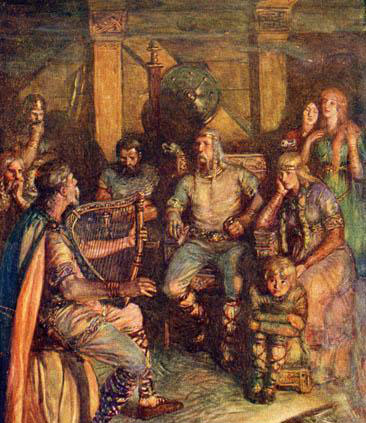 Two more days are left to enter the Back-to-School Giveaway.. If you don't feel comfortable leaving your contact information on the blog, you can e-mail it to editor@CatholicTextbookProject.com. You may leave a comment without your contact information, but remember to check the blog later in the week for the winner.
Two more days are left to enter the Back-to-School Giveaway.. If you don't feel comfortable leaving your contact information on the blog, you can e-mail it to editor@CatholicTextbookProject.com. You may leave a comment without your contact information, but remember to check the blog later in the week for the winner.Textbooks that tell the story of civilization in the universal Truth that is the Catholic Faith.
Tuesday, July 30, 2013
The Back-to-School Giveaway Continues
 Two more days are left to enter the Back-to-School Giveaway.. If you don't feel comfortable leaving your contact information on the blog, you can e-mail it to editor@CatholicTextbookProject.com. You may leave a comment without your contact information, but remember to check the blog later in the week for the winner.
Two more days are left to enter the Back-to-School Giveaway.. If you don't feel comfortable leaving your contact information on the blog, you can e-mail it to editor@CatholicTextbookProject.com. You may leave a comment without your contact information, but remember to check the blog later in the week for the winner.Saturday, July 27, 2013
Another Urgent Reason for Catholic Textbooks!
This article from Crisis Magazine shows why good Catholic history books are needed in every Catholic school and home.
After making tens of billions in the personal computer revolution, Gates has become a full-time cheerleader for leftist causes on a global scale—whether it’s reducing carbon emissions to zero by mid-century or reducing the world population by spending billions to pay for contraceptives in poor countries.
Follow Catholic Textbooks via Email
New Gates History Curriculum Closes Young Minds to God
There seems to be no limit to the ambition of Bill Gates.
 |
| Bill Gates |
Now Gates is hoping to transform education. The Microsoft co-founder has recently made headlineshere and elsewhere for backing a new nationalized curriculum known as the Common Core. But his ambitions for education are even bigger. Gates has recently teamed up with historian David Christian to launch the Big History Project, a free online curriculum piloted last year in 55 high schools—45 in the United States, including four Catholic ones, and ten in other countries, from China to the Netherlands.
Big History lives up only to the first part of its name. It encompasses a 13.7 billion year-timeline in a bold effort to tell the entire history of the universe.
But it is not really history in any recognizable sense of the word. History traditionally takes as its starting point recorded history beginning with stories of Egyptian mummies and pyramids, or perhaps in the cradle of civilization, Mesopotamia. Big History, on the other hand, begins with the Big Bang. The ten-unit course devotes nearly half its time to covering the formation of stars and the solar system, then turns to the birth of life and the appearance of the earliest humans, before arriving at history proper, in the seventh unit. It’s tailor-made for the attention-challenged student of today, with the typical unit featuring minutes-long video lectures, interactive exercises, and floridly illustrated articles.
Read the rest here.
To help us get good Catholic history books into more schools go here.
Friday, July 26, 2013
Textbook Giveaway and A Special Offer

Parents are seeing the end of summer fast approaching and are thinking of preparations for the new school year - choosing curricula, making lesson plans and purchasing new books. CTP has two offers to help.
A TEXTBOOK GIVEAWAY: A CTP history book of your choice with accompanying support materials. Please leave a comment to enter and please include some way of contacting you if you win. Entries will be taken through the end of July and the winner announced Thursday, August 1.
HOMESCHOOL GROUP ORDERS: Are you part of a homeschooling group or co-op? Combine orders and receive a 10% discount and free shipping on orders of five or more textbooks (any combination of our four books) shipped to the same address.* Contact your family, friends and neighbors and place an order before August 20.
This special offer is not available on the CTP website so call 661-823-9380 (Monday - Friday, 9am - 6pm PST) or email editor@CatholicTextbookProject.com to place your order.
*This offer is limited to homeschooling families and excludes retail businesses and schools.
Monday, July 22, 2013
New Book on the Cristero Rebellion
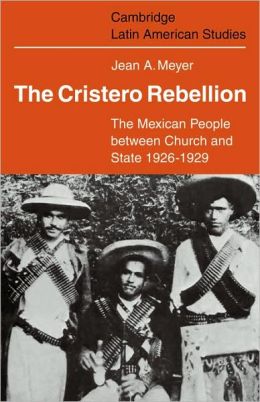 Dr. Meyer's earlier book, The Cristero Rebellion: The Mexican People Between Church and State 1926-1929 is also worth reading for those who want to delve deeper. This book is not an event-based history, but gives more of the sociological and cultural background of the Mexican peoples, reaching back to the 18th century.
Dr. Meyer's earlier book, The Cristero Rebellion: The Mexican People Between Church and State 1926-1929 is also worth reading for those who want to delve deeper. This book is not an event-based history, but gives more of the sociological and cultural background of the Mexican peoples, reaching back to the 18th century.
You can read an interview with with Jean Meyer in the Knights of Columbus' Columbia magazine.
You can also read more about the Cristeros in this excerpt from CTP's soon-to-be published history book Lands of Hope and Promise: A History of North America. Further, the Vatican website has short biographies on the beatified Catholic martyrs of the revolution.
Viva Cristo Rey y Nuestra Señora de Guadalupe!
Saturday, July 20, 2013
A Busy Week in France
 In France, this week began with celebration; for July 14 was "Bastille Day." The day commemorates the beginning of the French Revolution and the beginning of the end for the French monarchy and the ascendancy of the constitutional republic. The Bastille, a fortress in Paris, was the symbol to the Parisians of absolute, royal power. In it political opponents to the government had been imprisoned and it was a cache for the arms and ammunition which protected the royal power. A generation before, King Louis XV had sensed that his country was ripe for revolution. Amid the decadency, corruption, and oppression, he shrugged and predicted, Apres moi le deluge -- "After me, the flood." The storm broke violently when an armed mob stormed and seized the Bastille on July 14, 1789.
In France, this week began with celebration; for July 14 was "Bastille Day." The day commemorates the beginning of the French Revolution and the beginning of the end for the French monarchy and the ascendancy of the constitutional republic. The Bastille, a fortress in Paris, was the symbol to the Parisians of absolute, royal power. In it political opponents to the government had been imprisoned and it was a cache for the arms and ammunition which protected the royal power. A generation before, King Louis XV had sensed that his country was ripe for revolution. Amid the decadency, corruption, and oppression, he shrugged and predicted, Apres moi le deluge -- "After me, the flood." The storm broke violently when an armed mob stormed and seized the Bastille on July 14, 1789.
The storm increased in intensity during the following ten years, becoming more violent and indiscriminate, climaxing with "The Reign of Terror." The Church was an object of this violence since she was viewed as an ally of the monarchy and an enemy of Reason -- an idea developed in the secular humanism of the Enlightenment. Many religious were made martyrs during the upheaval, and, ironically, one group's death is remembered by the Church three days after Bastille Day. The Blessed Martyrs of Compiegne were 16 women from the Carmel of Compiegne, guillotined during the revolution. The following is their story, taken from CTP's Light to the Nations II: The Making of the Modern World.
The Martyrs of Compiègne
and the Fall of Robespierre
An excerpt
from Light to the Nations II: The Making of the Modern World, pp.
165-167
By
Christopher Zehnder
The Terror
now entered its darkest phase. Prisons in Paris began to overflow with
thousands of accused persons. Executions increased. In the year from the
beginning of the Reign of Terror to the passage of the Law of the 22nd
Prairial, Paris had seen 1,256 executions; but in the six weeks following
the passage of the law, 1,361 died under the guillotine. A steady stream of
victims, men as well as women, patriots as well as traitors, climbed the
scaffold. Among them was André Chenier, the poet who had composed the hymn to Robespierre’s god.
Among those who met their deaths during this period were the
Carmelite nuns of Compiègne. Since September 1792, when the National Assembly
had forced them to leave their monastery and abandon their habits, they had
continued to live their religious life in small groups, near to a chapel where
they heard Mass. But in June 1794, they were arrested for plotting against the
republic and taken to Paris. During their trial before the Revolutionary
Tribunal, the prosecuting attorney accused the nuns of being fanatics on
account of their “attachment to childish beliefs” and “silly religious practices.”
Without an attorney to defend them, the sisters were condemned as “enemies of
the people by conspiring against its sovereign will.” They were 16 in number—ten
professed nuns, one novice, three lay sisters, and two servants.
Read the rest here.
Wednesday, July 17, 2013
Online Classes
He also will delve into theology with a 12-week course entitled "Lumen Gentium: Theology for the Year of Faith". The text will be the principle document of the Second Vatican Council, Lumen Gentium (the Dogmatic Constitution of the Church) which can be found online free at the Vatican website. The suggested grade level is upper high school.
More information and a list of all Homeschool Connections' Fall 2013 Courses can be found here.
Monday, July 15, 2013
Giveaway Winner and a Freebie
 Ana Braga-Henebry, M.A. is the author of Catholic Textbook Project's workbooks. A prolific writer, homeschooling parent and co-op teacher, she has also written and directed drama for the elementary and high school level. So far, her subjects for children's performance include St. John Vianney, St. Margaret of Scotland, St. Benedict, and the Iliad and Odyssey. She offers her plays free of charge and information on downloading her scripts can be obtained through her blog. Ana has graciously allowed us to make available for download the script of The Twin Saints, a play about St. Benedict and his twin sister, Scholastica here.
Ana Braga-Henebry, M.A. is the author of Catholic Textbook Project's workbooks. A prolific writer, homeschooling parent and co-op teacher, she has also written and directed drama for the elementary and high school level. So far, her subjects for children's performance include St. John Vianney, St. Margaret of Scotland, St. Benedict, and the Iliad and Odyssey. She offers her plays free of charge and information on downloading her scripts can be obtained through her blog. Ana has graciously allowed us to make available for download the script of The Twin Saints, a play about St. Benedict and his twin sister, Scholastica here. |
| Sts. Scholastica and Benedict |
Congratulations, Jen!
Please e-mail editor@CatholicTextbookProject.com.
Saturday, July 13, 2013
The Good Henry
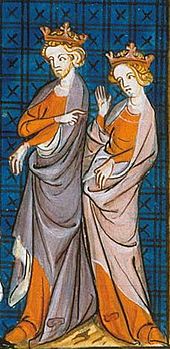 |
| Henry and Eleanor |
Probably one of the most difficult things to do when
studying history is keeping names, events, and dates coordinated. Like a novel
with many plot lines and characters, it can be a challenge to follow the story.
When I looked at the calendar and saw “Henry II” as the saint whose feast is
commemorated today, I had a first confused thought of Thomas a Becket’s Henry II. Such a man as that Henry
could not have been made a saint. Even though he did penance for his part in
Thomas’ martyrdom, he did not lead an exemplary life of heroic virtue. No, the name on the calendar was that of a Henry II who lived 150 years earlier in Germany and was not merely a
king, but a Holy Roman emperor. Naturally, it would be easier to keep the two Henrys
clear if Emperor Henry’s name was not anglicized in history
books, but remained the original, very German “Heinrich.”
| Heinrich and Kunigunde |
Unlike the English Henry II’s queen, Eleanor of Aquitaine, Emperor Henry II’s queen, Kunigunde, is
a canonized saint. Whereas Emperor
Heinrich worked in the 11th century to strengthen the Church in his empire and promote reform, King
Henry a century later tried to weaken the Church’s authority in his English realm. As is often
the case, though, the English Henry has more notoriety because of the trouble he
caused. As Shakespeare’s Marc Antony noted, “The evil that men do lives
after them; the good is oft interred with their bones.”
In Butler’s Lives of the Saints the entry for today’s royal saint ends with this profound thought:
Those who by honors, position, wealth, or talents are raised by God above the level of their fellow creatures in the world have a great stewardship and a rigorous account to give at the bar of divine justice; for their very example has a most powerful influence over others. This St. Fulgentius observed, writing to Theodore, a Roman senator. “Though,” said he, “Christ died for all men, yet the perfect conversion of the great ones of the world brings great acquisition to the kingdom of Christ. Those in high places must necessarily be to many an occasion either of eternal perdition or of salvation. And as they cannot go alone, so either a high degree of glory or an extraordinary punishment will be their everlasting portion.”
May we remember and follow the Good Henry.
Please Note: Today is the last day to enter the giveaway.
Thursday, July 11, 2013
Building a Citadel and a Giveaway
When I was growing up, St. Benedict seemed like a member of
our family, a deceased beloved uncle whose presence was still strongly felt. My
father, a convert to Catholicism, spent almost the entire decade of the '50’s in a Benedictine monastery. After he returned to the world, he became a
Benedictine oblate (a lay member of the order) and continued to pray daily the
Benedictine Office (similar to the Liturgy of the Hours) until his death in
2007. He was buried among other oblates in his monastic habit (a privilege of an oblate) in the
graveyard of a Benedictine abbey.
My father would frequently read to me and my siblings from
the Rule of St. Benedict of which we had as many copies as St. Benedict
medals. The likeness of the Father of Western Monasticism with a cocky raven
on his shoulder (a 4-foot high painting by my artist godfather) looked gravely down upon us in our living room. I recognized my own
father’s hands in the portrait as my godfather used them as a model, my father
holding a broom in place of an abbatial staff. There was also a large,
beautifully hand-carved, wooden statue of St. Benedict from the famous Fusek’s
in Los Angeles. If you examined it carefully you could detect where his
outstretched arm, raised in blessing had been reattached to his body often, the
result of vigorous in-door rough-housing. The small stone St. Benedict – which
for many years I wrongly thought was Moses because of his patriarchal demeanor and
written scroll – fared better and stood on the shelf with books by famous
Benedictine authors such as Hubert von Zeller. My father even wanted to name
me, the eldest, “Scholastica” after St. Benedict’s twin sister, but my mother
thankfully prevailed with the name of her own mother. I later willingly took
“Scholastica” as my confirmation name.
From an early age, I knew what the initials "O.S.B." after a
name meant. I knew the phrase “pray and work” (in English and Latin) as the
motto of the Benedictines and that every good Benedictine worked for his bread.
I knew religious order jokes, made at the expense of mendicants (“begging”
orders) and upstart groups (less than 700 years old). When the wearing of brown scapulars became popular among laypeople in the 80’s, my father declined to
wear one, snorting, “I’m a Benedictine, not a Carmelite.”
So, today – the feast of St.
Benedict - is prominent in my personal history. However, St. Benedict justly looms large in Western history. In Founded on a Rock: The History of the Catholic Church, author
Louis de Wohl writes of this famous monk.
Born in Nursia, Italy in 480 and sent to Rome for his studies, Benedict saw the corruption of Roman society and even of some of the priesthood. He witnessed the quarrel between two ecclesiastic factions, each with its own candidate for the papacy, and he felt that he needed solitude to give himself completely up to God. He found it in a cave in the hills near Subiaco.
Soon the people came to him to let him solve their problems for them. The monks of a nearby monastery asked him to become their abbot. But they also were corrupt and Benedict's rule was too severe for them. In the end they tried to poison him [Here, that cocky raven comes in to save his life, spilling the poisoned cup]. He left them and founded a number of monasteries of his own. When an evil priest attempted to make life impossible, he left for the South. On a steep mountain near the town of Cassinum he built a veritable fortress, a citadel of God. Here he wrote his famous Rule, one of the wisest documents of all time. It became the model for many other orders. It also revealed the character of the author - severe and yet kind, exact yet considerate, a man of supreme knowledge of human nature with all its virtues and weaknesses. He was a great sage and a great saint.
 |
| The Abbey of Monte Cassino |
All around the citadel of God the Roman world crumbled. Armies marched and counter-marched past it. They fought and died and vanished, but the citadel lived on. Here, and in other Benedictine monasteries founded by St. Benedict's spiritual sons, the great theological and literary treasures of the past were copied and stored, in an age in which barbarian people overran the old centers of culture and civilization, peoples who were not only illiterate but proud of the fact. Even Kind Theodoric of the Ostrogoths, ruler, master and lawgiver of Italy, could neither read nor write.
That today we possess not only Christian writings and indeed the Bible itself, but also the plays of Homer, Catullus and Horace, the play of Aeschylus, Sophocles and Euripides, the histories of Thucydides and Livy, the philosophical writings of Plato and Aristotle, all the priceless heritage of Graeco-Roman thought, we owe to these monks who copied and recopied the ancient scrolls and stored them away, against the time when the outside world would be tired of barbarism and war, and would long for the world of thought.
But more important even than that, more important than anything else to St. Benedict and his sons, was the stream of prayer they sent up and are still sending up, singing, seven times a day; forming a living bridge to the land of God, giving praise to Him for His goodness, and in doing so, keeping the whole world in balance.
Benedict himself died, an old man, held upright by his monks on the right and on the left, like Moses of old, and singing the praise of God until his voice gave out.


In honor of the feast of St. Benedict, CTP is giving away Louis de Wohl's classic Citadel of God: A Novel of St. Benedict and The Holy Twins: Benedict and Scholastica by Tomie dePaola. To enter please leave a comment.
Monday, July 8, 2013
The Glow and Power of Living Human Beings
When gathering information for a history textbook, a writer
usually reads some biographies and autobiographies of historical characters. A
student reading that same textbook may have his interest piqued in a particular
character and can learn more about that character through additional reading of
biographies. While reading an old literature textbook published in the 40’s for
Catholic high schools, I found a chapter on “Biography” and I thought its
description of that literary form well-expressed.
The historian traces the development of events in a
broad perspective, throwing his spotlight upon individuals only as he finds it
necessary to show their part in the shaping of the complete picture. The
biographer brings us figuratively face to face with some person whose life is significant because it is a record of human triumph or failure.
Certain paintings, such as a battle scene or a flash of
frontier life, present a realistic portrayal of action which is itself
spectacular. The action is caught without emphasis on any special figure. Other
paintings, fully as memorable, center attention upon a single character, whose
stature is stressed by the background against which it is drawn. It is in some
such manner that the historian differs from the biographer.
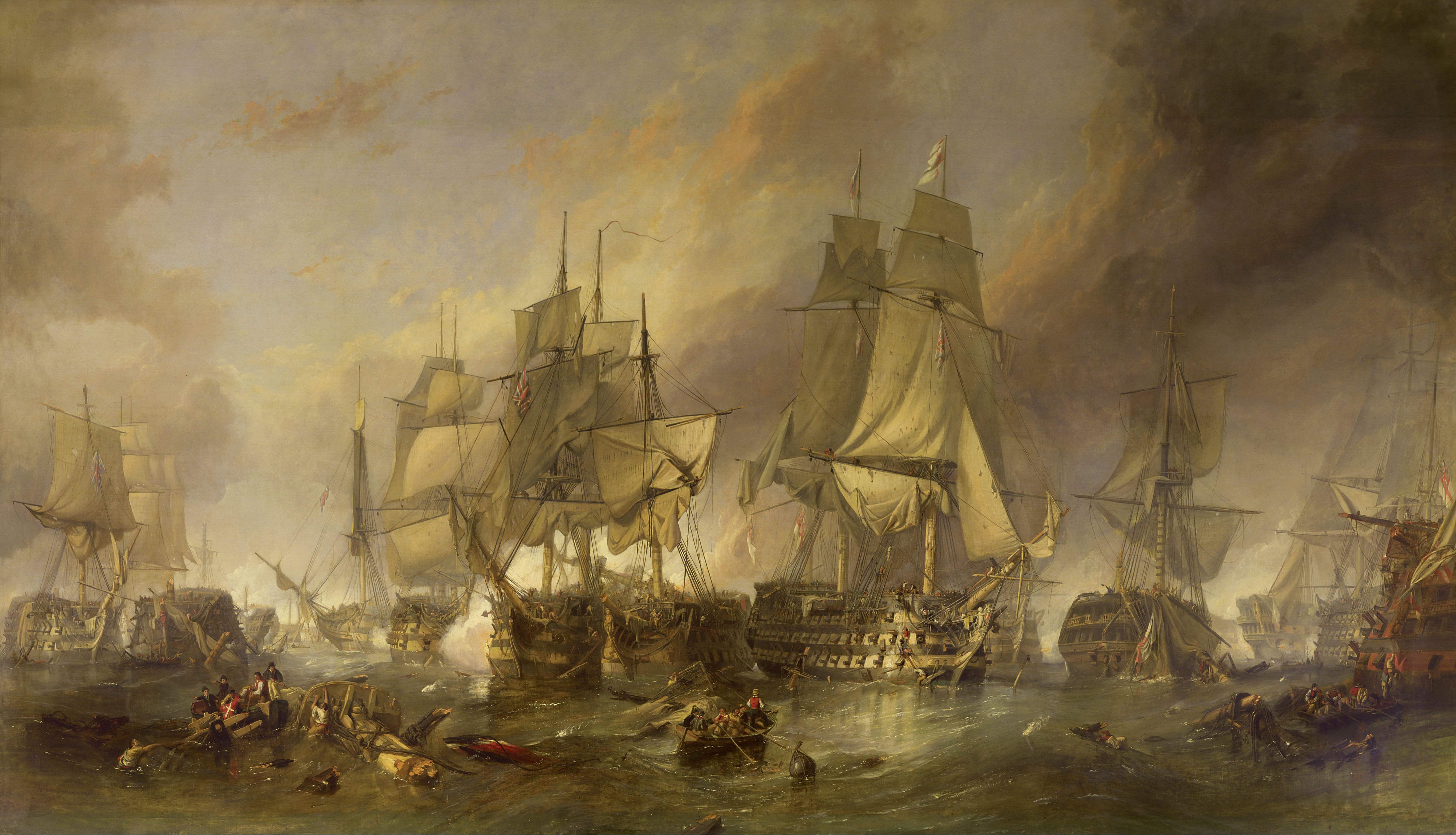 |
| The Battle of Trafalgar by W.C. Stanfield |
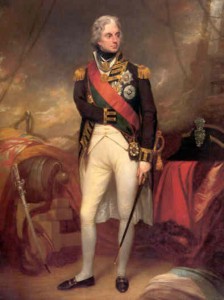 |
| Lord Nelson at Trafalgar |
The biographer has a role not less significant than that of the historian proper. By summoning great figures from the past and so investing them with the flesh of reality that they seem to live again, he enables us to understand more clearly the ways in which they walked, the work that was given them to do, and with what strength of spirit they met the tests of their time.
Biography in one form or another is as old as writing
itself. Primitive authors transmitted in boastful lines the exploits of popular
heroes. In the ancient books of the Hebrews and the tales of Celtic bards are
striking word pictures of patriot and chieftain.
This brought to my mind the
ending chapters of Tolkien’s Lord of the Rings. Not, of course, a history of a real place or events (much to the chagrin of true Middle Earth fans), the book contains patterns of past storytelling. It feels very authentic since Tolkien was a scholar of languages and literature.
"And when the glad shout
had swelled up and died away again, to Sam’s final and complete satisfaction
and pure joy, a minstrel of Gondor stood forth, and knelt, and begged leave to
sing. And behold! He said 'Lo! Lords and knights and men of valour unashamed,
kings and princes, and fair people of Gondor, and Riders of Rohan, and ye sons
of Elrond, and Dunedian of the North, and Elf and Dwarf, and greathearts of the
Shire, and all free folk of the West, now listen to my lay. For I will sing to
you of Frodo of the Nine Fingers and the Rings of Doom.'"
The 70-year old textbook continues:
Today the skillful biographer combines the vividness of
fiction with the accuracy of the historian. He is honest in acknowledging the
weak points of his subject. He aims to present the character truthfully against
the background of his times.
| G.K. Chesterton |
In his biography of St. Francis of
Assisi, G.K. Chesterton spends several pages laying out the different ways he could possibly tackle his
subject. Chesterton is critical of two particular writers who he does not think
did justice to St. Francis: “They were content to follow Francis with their
praises until they were stopped by their prejudices; the stubborn prejudices of
the sceptic. The moment Francis began to do something they did not understand
or did not like, they did not try to understand it, still less to like it; they
simply turned their backs on the whole business and ‘walked no more with him.’
No man will get any further along the path of historical enquiry in that
fashion.”
The textbook moves on to the autobiography:
When a person puts into writing the story of his own
life, the result is called autobiography. The great appeal of this literary
form is the quality of complete authenticity. The story is distilled directly
from the author’s experience. He unfolds with his own hand the testament of his
life, laying bare its secret chambers, its crises, its victories and defeats.
Sometimes an autobiography presents not so much the events of his life as a
struggle within his soul.
| John Henry Newman |
Here I think of St. Augustine’s Confessions
or Blessed Cardinal Newman’s Apologia pro Vita Sua or Dorothy Day’s From
Union Square to Rome and The Long Loneliness.
The rigid adherence to truth is the essential
characteristic of biographical writing.
"Rigid adherence to truth" is probably the most ticklish quality to achieve in an autobiograph because we human beings have a tendency to deceive ourselves or justify our actions or have perfect vision in hindsight. We like to be our own life editors so our best selves (or at least our best intentions) are shown to the world. Autobiographies may bring to light hidden actions or make secrets public, but it does not necessarily give an accurate account of the whole person. Often a third person account - a biography - adds to the personal picture. Journals and letters are a great contribution to finishing the portrait. And if a biography pretty well aligns with an autobiography in major points, that further tells us that the autobiographical subject was a person of integrity and honesty.
Finally, the author leaves his high school readers with this :
Biography, autobiography, and miscellaneous accounts of personal experience succeed if they present their subjects so truthfully that the reader feels the glow and power of living human beings.
Wednesday, July 3, 2013
Textbook Giveaway Winner
 The winner is... Jennifer Gant-Brush. Congratulations!
The winner is... Jennifer Gant-Brush. Congratulations!Jennifer, please e-mail CTP: editor@CatholicTextbookProject.com.
We'll be doing more giveaways of our textbooks and other books, so check this blog and facebook regularly.
Blessed feast of St. Thomas the Apostle to all.
Monday, July 1, 2013
A California Mission
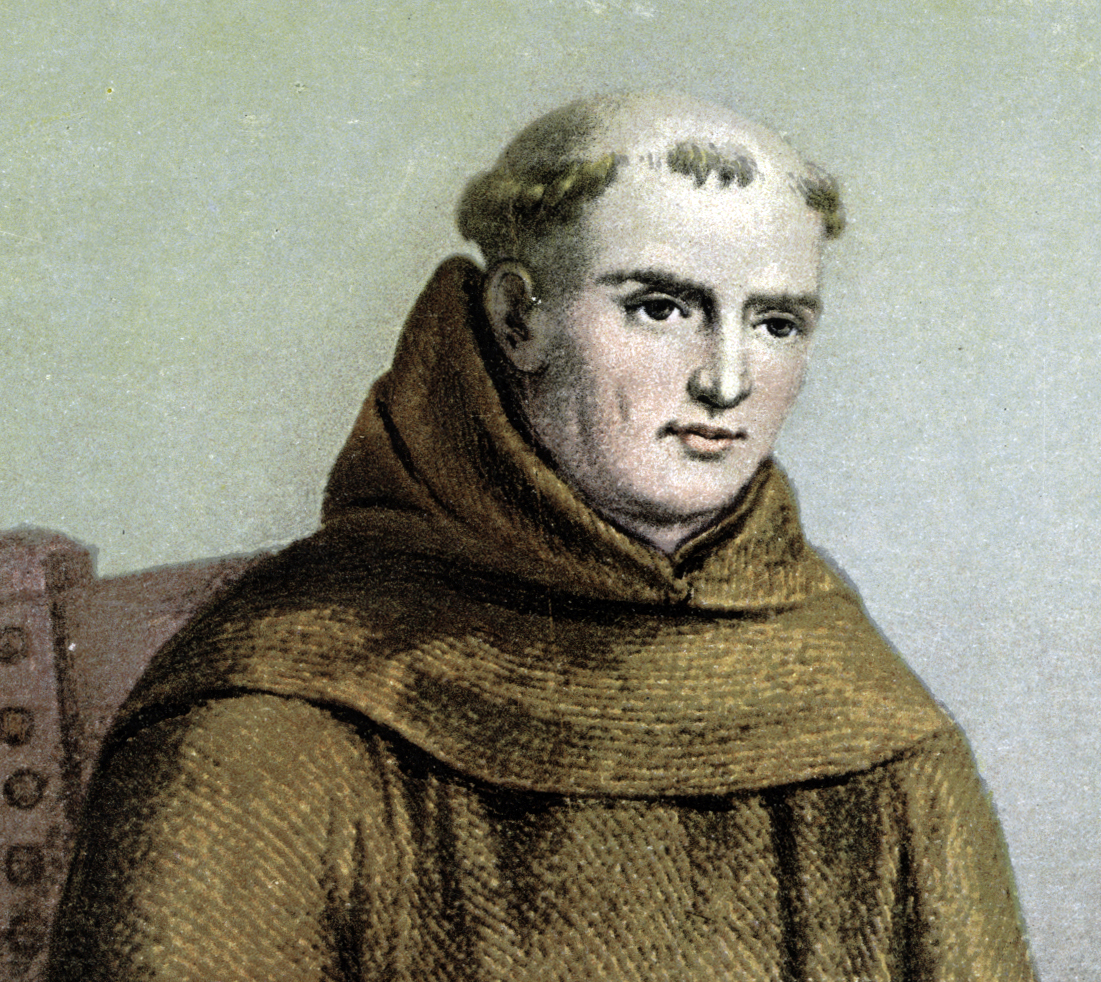 |
| Fray Juniper Serra |
Today is the feast of Blessed Junipero Serra, founder of the California missions. The Fresno Bee has an interesting article about the finding of a mission artifact at San Gabriel Mission.
Regarding the work of the Mission Indians, the lead archaeologist comments: "Most modern historians consider it to be forced labor."
In CTP's soon-to-be-published high school American history book, this misconception is corrected:
The Indians were not forced onto the missions, but invited; once they came and were baptized, however, they were under the authority of the missionaries and forbidden to leave. The missionaries not only taught the Indians the Catholic faith but various crafts, the art of farming, and cattle raising. The missionaries treated the Indians as children, with the aim to educate and train them so that mission pueblo and farms could eventually be turned over to them, and the missionaries replaced with secular priests. (Chapter 7, Lands of Hope and Promise: A History of North America)
It was the missionaries' experience that if the newly baptized and newly catechized Indians were allowed to live outside the mission, they soon fell back under the influence of the shamans or medicine men, who controlled them with fear and predictions of disaster for abandoning their old worship. There were also unscrupulous Spaniards, especially soldiers, who would take advantage of unprotected Indians, subjecting them to literal slavery.The Franciscan Friars saw themselves as true protectors of the Indians, both spiritually and physically, and formed the mission rules for the perceived good of their "spiritual children."
Remember: Tomorrow is the last day of the Textbook Giveaway. There is still time to enter.
Subscribe to:
Posts (Atom)




